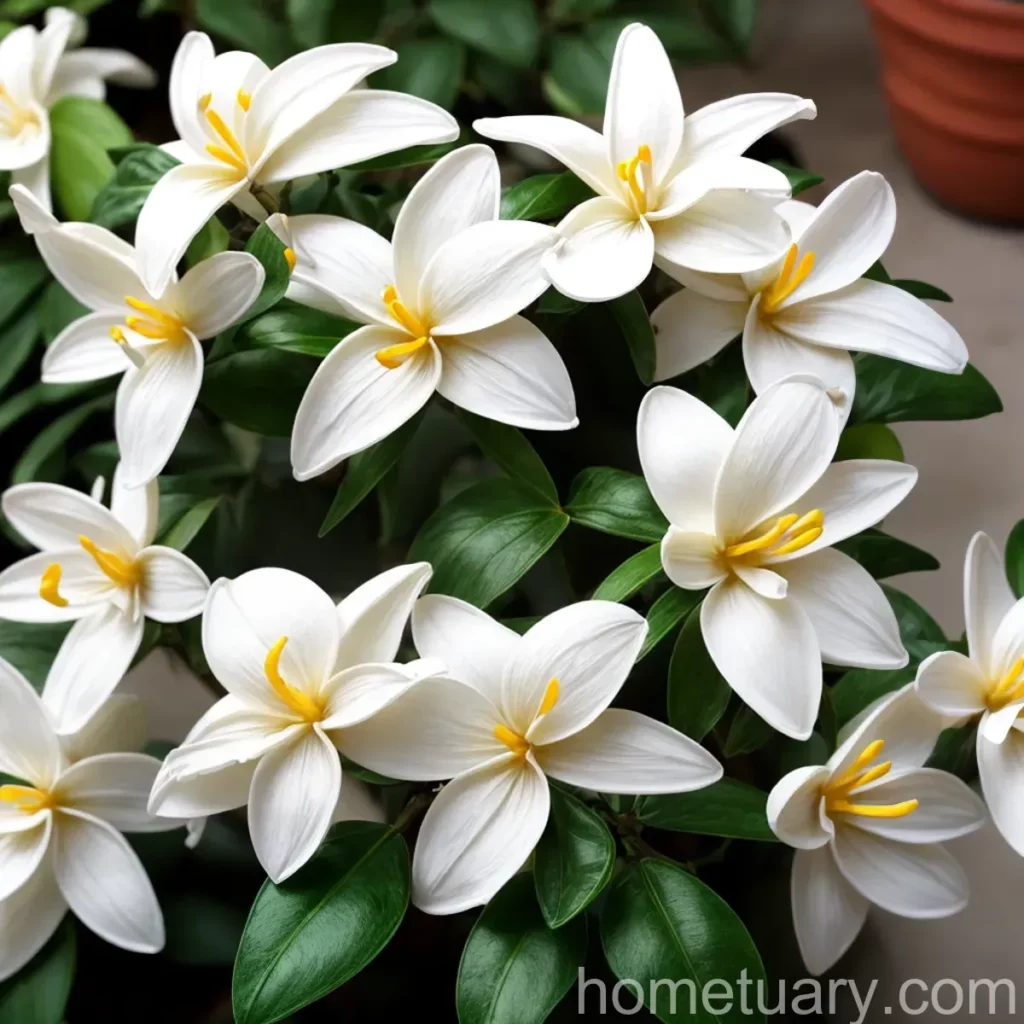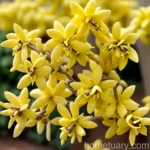The Allure of Arabian Jasmine (Jasminum sambac)
Plant Name: “Arabian jasmine (Jasminum sambac)”
What is Arabian Jasmine?
Arabian jasmine, scientifically known as Jasminum sambac, is an evergreen shrub that belongs to the Oleaceae family. This plant species is native to South and Southeast Asia, particularly India, Myanmar, and Sri Lanka. Known for its enchanting fragrance and delicate, white flowers, Arabian jasmine has been cherished for centuries in various cultures for its ornamental, medicinal, and spiritual significance.
Key Takeaways
-
Arabian jasmine plant: Aromatic, evergreen shrub with white, fragrant flowers.
-
Jasminum sambac: Scientific name for Arabian jasmine.
-
Arabian jasmine care: Requires well-draining soil, regular watering, and bright, indirect sunlight.
-
Growing Arabian jasmine: Suitable for both indoor and outdoor cultivation.
-
Jasmine plant varieties: Numerous cultivars with variations in flower form and fragrance.
-
Arabian jasmine flowers: White, star-shaped blossoms renowned for their sweet scent.
-
Jasminum sambac plant family: Belongs to the Oleaceae family, which also includes olive and lilac.
-
Arabian jasmine cultivation: Traditionally grown for its fragrant flowers and ornamental purposes.
-
Jasmine plant propagation: Can be propagated by seeds, cuttings, or air layering.
-
Arabian jasmine medicinal uses: Used in traditional medicine for its potential health benefits.
Culture
Arabian jasmine holds a special place in the cultures and traditions of several countries around the world. In various Asian cultures, including India, Philippines, and Indonesia, the flowers of Arabian jasmine are used to make traditional leis, garlands, and other floral decorations. These fragrant adornments are often presented to honored guests and used in religious ceremonies and wedding rituals. In many regions, Arabian jasmine is also associated with love, purity, and spiritual symbolism, and its flowers are used to create perfumes and essential oils.
Fun Facts
- Arabian jasmine has been an integral part of traditional Ayurvedic and Chinese medicine for its potential health benefits.
- The fragrance of Arabian jasmine is often described as captivating and intoxicating, making it a popular choice for perfumes and scented products.
- In various cultures, Arabian jasmine is believed to have aphrodisiac properties, and the flowers are used in preparations for wedding ceremonies and romantic occasions.
Uses
Medicinal Uses
In addition to its ornamental value, Arabian jasmine is revered for its potential medicinal properties. The flowers are used in traditional Ayurvedic and Chinese medicine systems for their purported calming, antidepressant, and aphrodisiac effects. The essential oil derived from the flowers is also used in aromatherapy and skincare products for its soothing and rejuvenating properties.
Culinary Uses
In certain cuisines, Arabian jasmine flowers are utilized to infuse teas, desserts, and beverages with their distinctive floral fragrance. The flowers are often added to green or black tea to impart a delicate floral aroma and flavor, creating a soothing and aromatic beverage.
Landscape Uses
Arabian jasmine is a popular ornamental plant used in landscaping for its fragrant flowers and evergreen foliage. It can be grown as a hedge, in borders, or as a standalone specimen, adding beauty and fragrance to gardens, parks, and outdoor spaces.
Perfumery and Essential Oils
The sweet, floral fragrance of Arabian jasmine has made it a prized ingredient in perfumery for centuries. The flowers are used to extract essential oil, which is a key component in the creation of exotic and luxurious perfumes, as well as scented candles, soaps, and skincare products.
Growing Conditions
Arabian jasmine is relatively easy to grow and maintain, provided it receives the proper care and growing conditions. Whether cultivated indoors or outdoors, certain factors such as water, sunlight, soil, and fertilizer are essential for the health and vigor of the plant.
Water
Regular watering is crucial for the growth and flowering of Arabian jasmine. The soil should be kept consistently moist, but not waterlogged, particularly during the growing season. Avoid allowing the soil to dry out completely between waterings, as this can lead to stress and decreased flower production.
Sunlight
Arabian jasmine thrives in bright, indirect sunlight, making it well-suited for indoor cultivation. When grown outdoors, it benefits from partial shade, especially during the hottest part of the day. Insufficient light can lead to reduced flowering and weakened growth, so providing the right amount of light is essential.
Fertilizer
To encourage healthy growth and abundant flowering, feed Arabian jasmine with a balanced, water-soluble fertilizer every 4-6 weeks during the growing season. A fertilizer specifically formulated for flowering plants or acid-loving plants can provide the essential nutrients needed for robust growth and blooming.
Soil
Well-draining, slightly acidic soil is ideal for Arabian jasmine. A mix of peat moss, perlite, and garden soil can create a suitable growing medium for potted plants. Outdoors, the plant thrives in fertile, loamy soil with good drainage, helping to prevent waterlogging and root rot.
Pruning and Maintenance
Regular pruning is beneficial for Arabian jasmine to maintain its shape, control its size, and promote branching and flowering. Removing dead or damaged branches, as well as spent flowers, encourages new growth and blooming. Pruning is typically done after the flowering season to avoid disrupting the development of flower buds.
Propagation
Arabian jasmine can be propagated through various methods, including:
- Seeds: Sow fresh seeds in a well-draining seed-starting mix and maintain consistent moisture until germination occurs.
- Cuttings: Take 4-6 inch stem cuttings from a healthy, mature plant and root them in a moist rooting medium, such as perlite or vermiculite.
- Layering: Encourage root formation on a lower branch by bending it to the ground, covering it with soil, and allowing it to establish roots before severing it from the parent plant.
Propagation by cuttings is a common and reliable method, often resulting in faster establishment and flowering compared to seeds.
Container Cultivation
Arabian jasmine is well-suited for container cultivation, making it an excellent choice for indoor and patio gardening. Use a well-draining potting mix and a container with drainage holes to ensure proper moisture levels and prevent waterlogging. Container-grown plants may require more frequent watering and fertilization than those grown in the ground.
Common Diseases and Pests
Like any plant, Arabian jasmine is susceptible to certain diseases and pests that can affect its health and appearance. Being aware of these potential issues and knowing how to address them is essential for maintaining the vitality of the plant.
Common Diseases
1. Fungal Diseases: Arabian jasmine may be prone to fungal infections, such as powdery mildew and leaf spot, particularly in humid or poorly ventilated conditions. Use appropriate fungicidal treatments and improve air circulation to prevent and manage these issues.
2. Root Rot: Overwatering or poorly-draining soil can lead to root rot, which manifests as yellowing or wilting leaves and stunted growth. Adjust watering practices and improve soil drainage to prevent the development of root rot.
Disease Diagnosis
Identifying and diagnosing diseases in Arabian jasmine involves observing the plant for symptoms such as yellowing or spotted leaves, wilting, or unusual growth patterns. Close inspection of the plant and its growing environment can provide valuable clues regarding the nature of the problem, enabling appropriate treatment and management.
Common Pests
1. Aphids: These small, soft-bodied insects feed on the sap of the plant, causing distorted growth and the secretion of sticky honeydew. Control aphids by spraying the plant with insecticidal soap or horticultural oil.
2. Whiteflies: Whiteflies are tiny, winged insects that congregate on the undersides of leaves and can weaken the plant with their feeding. Use insecticidal treatments to manage whitefly infestations and prevent their spread.
Botanist’s Tips
- To encourage prolific flowering, provide Arabian jasmine with a consistent temperature and light cycle, as sudden changes can disrupt its blooming pattern.
- Regularly inspect the plant for signs of pests and diseases, addressing any issues promptly to prevent them from spreading and causing damage.
- Consider growing Arabian jasmine indoors during colder months, providing it with sufficient light and warmth to maintain its growth and vigor.
Popularity
Arabian jasmine’s popularity spans numerous cultures and traditions, where it holds significant symbolic and practical value. From traditional medicine and perfumery to religious customs and wedding ceremonies, the allure of Arabian jasmine has endured through time, captivating people with its aromatic blossoms and cultural significance.
Links to External Resources
For further information on Arabian jasmine and related topics, consider exploring the following resources:
- Arabian Jasmine: Horticulture Information
- Jasminum sambac: Growing Jasmine Plants
- Uses of Arabian Jasmine in Ayurveda
- Traditional and Medicinal Uses of Arabian Jasmine
- Cultural Significance of Arabian Jasmine
In conclusion, Arabian jasmine, or Jasminum sambac, is a captivating and versatile plant with a rich history steeped in culture, tradition, and symbolism. Its fragrant flowers and potential therapeutic uses have endeared it to people across the globe, making it a cherished and iconic botanical species. Whether grown for its ornamental beauty, aromatic essence, or traditional significance, Arabian jasmine continues to captivate and inspire those who appreciate its timeless allure.
The waters of growth nourish the roots of tradition, and in the case of Arabian jasmine, this connection is manifested in the delicate, star-shaped flowers that have bridged the past with the present, and continue to bloom with enduring grace.















